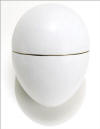Page 1 Introduction Fabergé
Page 2 Introduction Fabergé continued
Page 3 Short Biography
of Tsar Nicholas II: Childhood and marriage Nicholas II -
The coronation - The family - The church - The state - Court life - The end
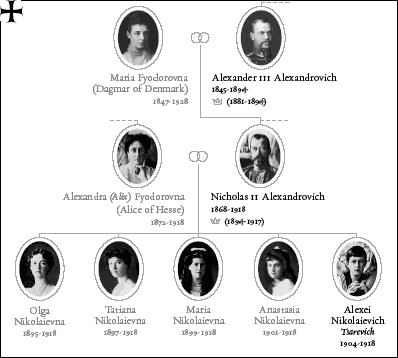
Born Peter Karl Fabergé* on May 30 (18) in 1846, he would become the most famous goldsmith of his time. Son of jeweler Gustav Fabergé, owner of a small silver and jewelry shop in St. Petersburg.

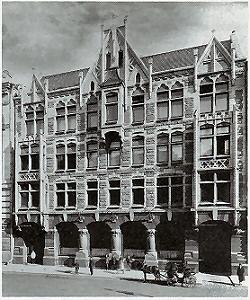
Peter Karl Fabergé
and right the shop in Sint Petersburg
Karl Fabergé was well-trained in the jeweler's art by apprenticeships in the major centers of the European decorative arts. By the time Karl was twenty, he had also received a solid foundation in economics and commercial affairs.
When Karl took over his father's jewelry firm in 1872 at the age
of twenty-four, it was not much different from several other workshops
catering to the upper classes of St. Petersburg. But the young Fabergé was determined to distinguish
the family name. Jewelry and the decorative arts of the day had previously been
valued by the size and weight of the precious stones and metals. In a departure
from such gaudy ostentation, and with the help of his younger brother Agathon,
a talented designer and valued advisor, Fabergé eagerly formulated a new
aesthetic, which he hoped would capture the fancy of the Russian aristocracy.
According to Fabergé collector Christopher Forbes, "His feeling was that
it should be creativity and craftsmanship rather than carat-content that dictated
the appreciation of a piece – and he certainly had a wonderful sense of humor.
So his pieces caught the attention of Alexander III, who admired them as examples
of Russian genius."
"And here you see the shrewd man, the businessman," says author and Fabergé expert,
Géza von Habsburg. "He worked for an institution called the Imperial Cabinet,
which was in charge of all the treasures of the Tsars in the Hermitage. And he
worked there free-of-charge and repaired things, appraised things, and so on." Having
earned the recognition of this prestigious organization by virtue of his expertise
in the task of restoring its collections, Fabergé was invited in 1882
to participate in the Moscow Pan-Russian Exhibition, where he earned a gold medal
and a good deal of press for his innovative work. It was at this event that Tsar
Alexander III and his wife, Maria Feodorovna, became acquainted with the House
of Fabergé, captivated by the exquisite display of jewels and objects
de luxe.
In 1885, Fabergé's hard work, meticulous standards and shrewd positioning
paid off when he was given the highest honor possible for a jeweler: an appointment
as "Supplier to the Court of His Imperial Majesty." That same year he received
the now famous order from the Tsar to create the first Imperial Easter egg for
the Tsarina.
The Eggs Alexander III ordered for Maria Feodorovna. They total ten, but three are missing. To see a list of all Eggs, to the Eggs!
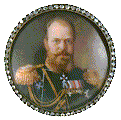
Alexander III
"Once you were one of the approved suppliers to
the Crown, it was a very lucrative source of business," says
Fabergé expert Christopher Forbes. "Every
time the Tsar went on a visit or received another head of state, there was
an exchange of gifts. Also Russia was growing as an industrial
power, and Fabergé was
catering to this whole class of nouveau riche Russians. The Imperial eggs were
his loss leaders to give him the cachet. But the cash was all coming from these
newly minted millionaires in Russia."
Author Géza von Habsburg continues: "And when the Tsar and Tsarina traveled,
they traveled with suitcases full of Fabergé, which were presented here
and there to people in thanks. By 1896, the year of the coronation of Nicholas
II, virtually all the major presents came from Fabergé."
But ironically, the man who conceived of and hand-delivered these incredible
pieces had little to do with their actual fabrication. According to Christopher
Forbes: "Fabergé was the head of the firm. He had the best designers,
the best goldsmiths, the best jewelers, the best stonecutters, the best miniaturists
all working for him. At the height of the success of the firm he
had over five hundred employees, four shops in Russia, one shop
in London and a catalogue operation. He provided the taste and
the direction, and he was the genius that got all these artists
and artisans to work together to produce these incredible fantasies."
These men were organized into autonomous workshops under master craftsmen
hand-picked by the Fabergé brothers. "The head workmasters
were the key persons in the realm of Fabergé," says author
Géza Von Habsburg. "They stood
at the apex of the pyramid immediately under Fabergé, and they controlled
the entire output of the workshops. The inventions came from Fabergé.
These were discussed with the head work masters, then taken to the design studio."
The process of making the Eggs usually took about one year. After the preliminary period of detailed and meticulous planning, sketches and models were prepared. Discussions were held among the goldsmiths, silversmiths, enamellers, jewelers, lapidary workers and stonecutters who would contribute their talents to the finished creation. Then the parts were farmed out to the various Fabergé workshops.
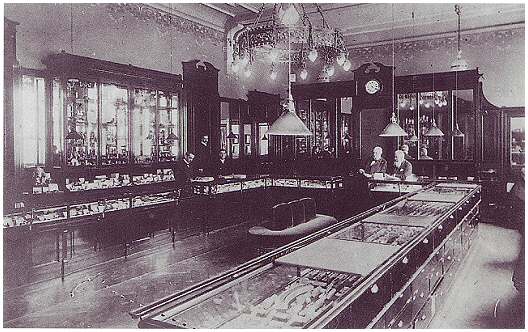
The shop in Sint Petersburg, ca 1905
* The name on his birth certificate [1] was Peter Karl Fabergé. He used the initials KF in his workmaster mark ![]() for the domestic market and the initials CF
for the domestic market and the initials CF ![]() for the foreign markets. As the Russian language only knows the K for the consonant [ka] on this website the name Karl (and not Peter Carl) Fabergé is used.
for the foreign markets. As the Russian language only knows the K for the consonant [ka] on this website the name Karl (and not Peter Carl) Fabergé is used.
In case you want to read more about Fabergé's workmasters and their marks, click here for an article on the Fabergé Research Site.
[1] Ulla Tillander-Godenhielm, Fabergé ja hänen suomalaiset mestarinsa, 2008, 18-19
aw
Read more on the next page: ![]() Fabergé Introduction - 2
Fabergé Introduction - 2
Page updated:
June 2, 2016

